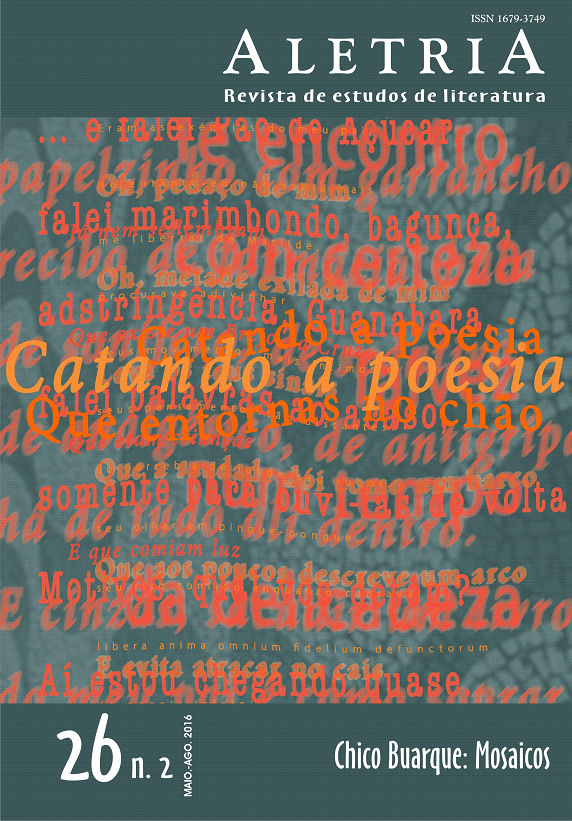“Within the Embroidered Way”: Matilde From the Novel Leite Derramado and Matelda From A Divina Comédia
DOI:
https://doi.org/10.17851/2317-2096.26.2.83-101Keywords:
Chico Buarque, Leite derramado, Matilde, Matelda, A divina comédiaAbstract
From the Bakhtin’s view of the text as a dialogic, polyphonic game, this paper seeks to establish a comparison between the characters Matilde from the novel Leite derramado, by Chico Buarque, and Matelda of A divina comédia, by Dante Alighieri. By tracing the links between such creations, this reading highlights the presence of the classical tradition in the novel and the carnivalization process of the language responsible for mixing the sacred and the profane, religion and eroticism, beatitude and sensuality: aspects that give Buarque’s Matilde a compelling figurative expression.
Downloads
References
ALIGHIERI, Dante. A divina comédia. Tradução de Cristiano Martins. Belo Horizonte: Itatiaia, 2006.
ALIGHIERI, Dante. Divina comédia. Tradução de João Trentino Ziller. Cotia: Ateliê Editorial; Campinas: Editora da Unicamp, 2011.
AUERBACH, Erich. Figura. Tradução de Duda Machado. São Paulo: Ática, 1997.
BAKHTIN, Mikhail. A cultura popular na Idade Média e no Renascimento. O contexto de François Rabelais. 7. ed. Tradução de Yara Frateschi Vieira. São Paulo: HUCITEC, 2010.
BAKHTIN, Mikhail. Problemas da poética de Dostoiévski. 5. ed. Tradução de Paulo Bezerra. Rio de Janeiro: Forense Universitária, 2010.
BORGES, Jorge Luis. Nove ensaios dantescos. Tradução de Wanda Ramos. Lisboa: Editorial Presença, 1982.
BUARQUE, Chico. Entrevista para a revista Nossa América, em 1989. Disponível em: www.chicobuarque.com.br/texto/mestre.asp?pg=entrevista/entre_1989.htm. Acesso em: 15 set. 2014.
BUARQUE, Chico. Geni e o zepelim. In: CHEDIAK, Almir. Songbook: Chico Buarque. São Paulo: Irmãos Vitale, 2010. v. 1. p. 110-113.
BUARQUE, Chico. Leite derramado. São Paulo: Companhia das Letras, 2009.
CANDIDO, Antonio. Formação da literatura brasileira. Momentos decisivos. 11. ed. Rio de Janeiro: Ouro sobre o Azul, 2007.
CHEVALIER, Jean; GHEERBRANT, Alain. Dicionário de símbolos: mitos, sonhos, costumes, gestos, formas, figuras, cores, números. Tradução de Vera da Costa e Silva et al. 19. ed. Rio de Janeiro: José Olympio, 2005.
FREUD, Sigmund. Três ensaios sobre a teoria da sexualidade. Tradução de Jayme Salomão. Rio de Janeiro: Imago, 1972.
KRISTEVA, Júlia. Introdução à semanálise. Tradução de Lúcia Helena França Ferraz. 2. ed. São Paulo: Perspectiva, 2005.
MENESES, Adélia Bezerra de. Figuras do feminino na canção de Chico Buarque. 2. ed. Cotia: Ateliê Editorial, 2001.
PERES, Ana Maria Clark. Chico Buarque, leitor de Dante. In: XVI CONGRESO DE LA FEDERACIÓN INTERNACIONAL DE ESTUDIOS SOBRE AMÉRICA LATINA Y EL CARIBE, 2014, Antalya. El viejo mundo y el nuevo mundo en la era del diálogo. Ankara: Universidad de Ankara – Centro de Estudios Latinoamericanos, 2014. v. I, p. 711-719.
ROUGEMONT, Denis de. O amor e o Ocidente. 2. ed. Lisboa: Veja, 1999.
Downloads
Published
How to Cite
Issue
Section
License
Copyright (c) 2016 Alexsandra Loiola Sarmento (Autor)

This work is licensed under a Creative Commons Attribution 4.0 International License.
Authors who publish with this journal agree to the following terms:Authors retain copyright and grant the journal right of first publication with the work simultaneously licensed under a Creative Commons Attribution Non-Commercial No Derivatives License that allows others to share the work with an acknowledgement of the work's authorship and initial publication in this journal.Authors are able to enter into separate, additional contractual arrangements for the non-exclusive distribution of the journal's published version of the work (e.g., post it to an institutional repository or publish it in a book), with an acknowledgement of its initial publication in this journal.Authors are permitted and encouraged to post their work online (e.g., in institutional repositories or on their website) prior to and during the submission process, as it can lead to productive exchanges, as well as earlier and greater citation of published work (See The Effect of Open Access).





